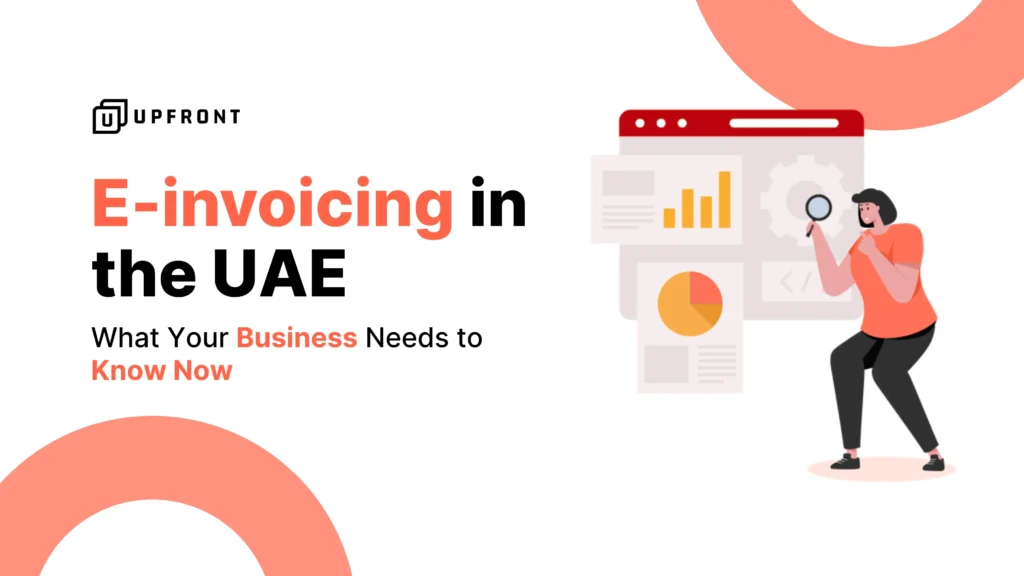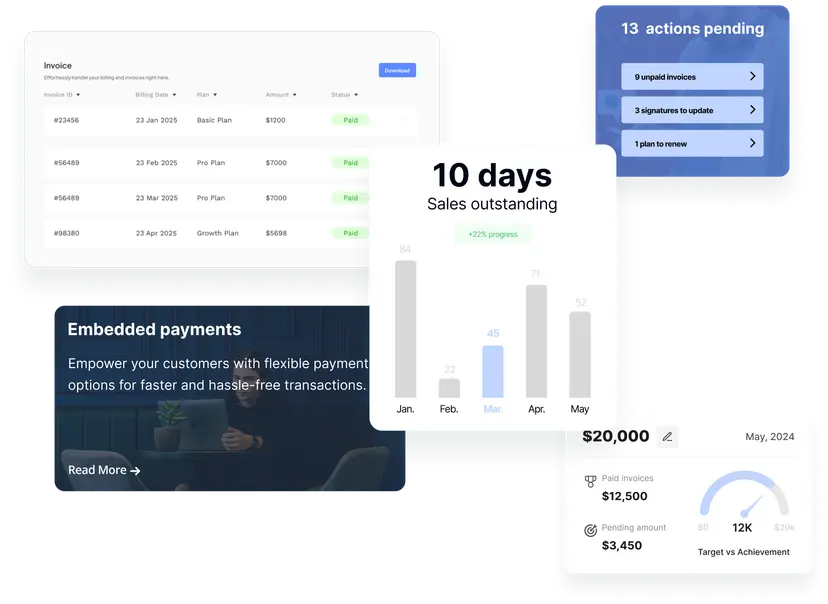Unlock a seamless transition to electronic invoicing with industry-leading solutions, compliance tips, and automation tools like UPFRONT—a modern accounts receivable automation platform designed for UAE business success.
E-Invoicing UAE 2025 & the Future of Business Compliance
The digital transformation sweeping through the UAE is redefining business operations, especially with the mandatory implementation of e-invoicing UAE 2025. Designed to regulate, automate, and future-proof tax and financial processes, e-invoicing in the UAE empowers organizations to achieve faster payments, stronger compliance, and operational efficiency. As regulatory deadlines approach, both finance professionals and SMEs are seeking the best e-invoicing system UAE and trusted software solutions for seamless tax compliance and automation.
What is E-Invoicing in the UAE? (FTA, Free Zones, & VAT Compliance)
E-invoicing (electronic invoicing) in the UAE is the government-mandated process for creating, sending, receiving, and archiving invoices in an approved digital format. The UAE tax e-invoicing system, governed by the Federal Tax Authority (FTA), ensures real-time reporting, transparency, and fraud prevention across all VAT-registered entities—including free zone companies.
All VAT-registered businesses, including those operating within UAE free zones, must comply with electronic invoicing UAE FTA requirements. This means using approved, automated systems capable of generating, storing, and submitting VAT-compliant e-invoices directly to the FTA. The regulatory framework ensures businesses benefit from simplified compliance, robust audit trails, and secure, paperless transactions.
Key Benefits: Why E-Invoicing Solutions Matter for UAE Businesses
1. Ensure E-Invoicing Compliance UAE: Avoid Fines & Audits
Using e-invoicing software UAE helps businesses meet all FTA e-invoicing requirements, from digital signatures to structured invoice formats. Compliance minimizes the risk of fines, audits, and delayed payments, safeguarding your reputation and financial health.
2. Automation & Efficiency: Leverage AR Automation Tools
With e-invoice automation UAE and integration into AR automation tools, repetitive manual tasks vanish. Automated workflows speed up invoice generation, reduce errors, and enable quick, secure sharing of invoices and payment data.
3. Real-Time Invoice Reporting UAE
Modern e-invoicing solutions connect directly with the FTA and tax portals for instant, real-time invoice reporting UAE. This feature is essential for accurate VAT accounting and regulatory submissions, making audits effortless.
4. Streamlined Financial Operations for SMEs & Enterprises
Adopting e-invoicing software accelerates payment cycles, improves cash flow, and ensures precise VAT reporting. Automation means AR teams spend less time on paperwork and more on value-driven financial management.
5. Scalability & Business Growth
The best e-invoicing system UAE supports growing companies, enabling smooth scaling from small businesses to large enterprises. You can expand operations or transaction volumes with confidence, knowing your compliance is future-proof.
Step-by-Step Guide: How to Comply with E-Invoicing in UAE (2025 and Beyond)
Step 1: Understand FTA E-Invoicing Requirements 2025
Familiarize yourself with the latest FTA e-invoicing requirements, including the necessity to use structured XML or JSON formats and real-time reporting protocols. These rules apply to both VAT-registered mainland and free zone businesses.
Step 2: Register for VAT & Setup E-Invoicing
Register your business for VAT if not already done. Ensure your invoicing solution is suitable for e-invoicing for VAT-registered businesses UAE and meets FTA accreditation standards.
Step 3: Select the Best E-Invoicing Software UAE
When choosing an e-invoicing solution for businesses in UAE, prioritize compliance with electronic invoicing UAE FTA standards, seamless AR automation, and reliable UPFRONT e-invoicing integration UAE.
Step 4: Integrate AR Automation & E-Invoicing
Implement e-invoicing with AR automation tools to eliminate manual tracking, automate reminders, and accelerate receivables. Real-time invoice reporting and payment reconciliation become much simpler.
Step 5: Test, Validate, and Continuously Monitor Compliance
Before going live, thoroughly test your system’s integration with the FTA and verify all compliance measures. Set up ongoing monitoring to stay updated with evolving FTA e-invoicing requirements.
How to Choose the Best E-Invoicing Software for Businesses in the UAE
Choosing the right provider is crucial. Key features include:
- Full FTA compliance (including Peppol, XML/JSON, VAT integration)
- E-invoice automation UAE with customizable workflows
- Robust AR automation tools for quick reconciliation and payment collection
- Secure data hosting and encrypted, auditable storage
- User-friendly dashboards and real-time reporting
- Scalability for SMEs and large corporations
- UPFRONT’s seamless e-invoicing and FTA integration for fast go-live and maximum efficiency
Why UPFRONT Stands Out
UPFRONT is a leading, modern accounts receivable automation platform, trusted by businesses across the UAE. UPFRONT’s solution delivers end-to-end automation, making it the optimal choice for:
- Easy, compliant UAE e-invoicing software for small business and enterprises alike
- Real-time, FTA e-invoicing compliance UAE integrations
- Effortless scaling as your business grows
- Direct focus on getting your business paid faster—no more bottlenecks or manual errors
- Leading customer support and guidance throughout your e-invoicing journey
When speed, accuracy, and seamless integration matter, UPFRONT offers the best e-invoicing system UAE for 2025 and beyond.
E-Invoicing vs. Manual Invoicing: Compliance, Speed, and Savings
E-invoicing offers dramatic advantages for businesses required to comply with the UAE tax e-invoicing system. Compare the two approaches below:
| Feature | Manual Invoicing | E-Invoicing (with UPFRONT) |
|---|---|---|
| Compliance | Risk of errors, non-compliance | Fully compliant with FTA standards |
| Process Time | Slow, prone to delays | Automated, faster turnaround |
| Error Rate | High, manual entry | Minimal errors, automation |
| Costs | Expensive (paper, storage) | Reduced costs, digital & scalable |
| Real-Time Reporting | Not available | Instantly enabled with FTA integration |
The difference between e-invoicing and manual invoicing UAE is clear: digital solutions outperform paper-based methods in speed, compliance, and efficiency—especially when you use platforms like UPFRONT.
FAQs on E-Invoicing for the UAE in 2025
1. Who must comply with e-invoicing UAE 2025 regulations?
All VAT-registered businesses in the UAE, both in mainland and free zones—regardless of size—must implement FTA-compliant e-invoicing for B2B and B2G transactions.
2. What is the e-invoicing compliance UAE timeline?
E-invoicing is phased in across:
- 2024: FTA begins accrediting service providers and finalizing standards
- 2025: Large businesses start integration
- July 2026: Mandatory for all VAT-registered companies and SMEs
3. Which e-invoicing software UAE is required?
FTA-accredited platforms supporting XML/JSON formats, real-time FTA integration, secure storage, and strong AR automation—like UPFRONT—are required for seamless compliance.
4. How do I integrate my system for FTA e-invoicing requirements?
Connect your ERP or accounting system to an Accredited Service Provider (ASP) with full e-invoicing and FTA integration. UPFRONT specializes in quick, smooth integrations for all UAE businesses.
5. What happens if I miss the e-invoicing deadline?
Non-compliance can result in FTA penalties, VAT refund delays, or operational risks. Early adoption ensures smooth operations and legal protection.
6. What are the requirements for e-invoicing?
Businesses must generate and store invoices electronically in formats like XML or JSON, ensure real-time integration with the FTA, use an Accredited Service Provider, and include all mandatory tax and business fields. The system must validate data, allow secure archiving, and follow UAE Peppol and VAT regulations.
7. What is e-invoicing and how does it work?
E-invoicing is the electronic creation, exchange, and storage of invoices using structured digital formats. In the UAE, e-invoices are issued through accredited platforms, validated for compliance, reported in real time to the FTA, and stored securely to streamline tax and accounting processes.
8. What is the invoice number in UAE?
The invoice number is a unique sequential identifier assigned to each invoice as required by UAE VAT law. This number must not be duplicated and should enable both the business and the FTA to track and audit invoices efficiently.
9. Can I issue an invoice without VAT in the UAE?
Invoices without VAT can only be issued for exempt or out-of-scope supplies, or by businesses not registered for VAT. If your business is VAT-registered, all taxable transactions must include VAT details. Always ensure compliance with current tax regulations to avoid
Optimize E-Invoicing Compliance & Automation with UPFRONT
Adopting e-invoicing UAE 2025 solutions is the smart way to future-proof your business. With UPFRONT, you get a trusted partner for:
- Fast, compliant e-invoicing system implementation
- Automation that gets your business paid quicker and keeps AR running smoothly
- Seamless compliance with all FTA and VAT rules—today and as they change
- Outstanding support for SMEs, enterprises, and free zone companies
Take control of your compliance and cash flow—start your e-invoicing transformation with UPFRONT today. Unlock growth, security, and efficiency with a system built for modern UAE businesses.
→ Secure your collaboration: Cloud AR Security→ Fraud-proof transactions: Secure B2B Payments→ Compliance simplified: E-Invoicing in UAE→ Regulatory clarity: Digital vs Compliant Invoicing UAE





